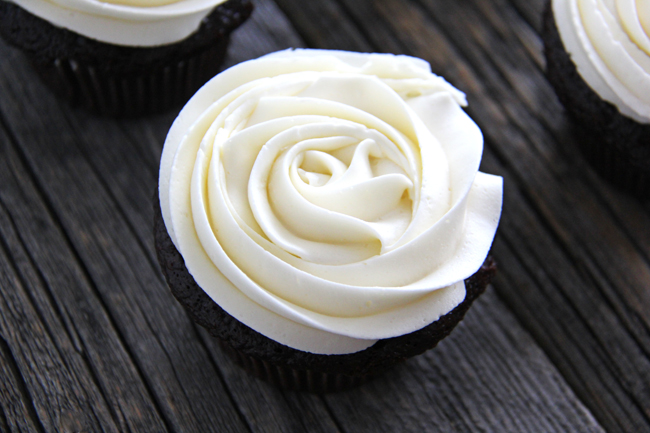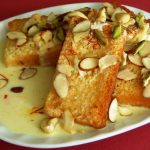Vanilla Buttercream Frosting is a classic and versatile frosting used for cakes, cupcakes, and other baked goods. It’s rich, creamy, and has a perfect balance of sweetness with the aromatic flavor of vanilla. This frosting is a favorite among bakers for its smooth texture and ability to be easily piped or spread on cakes.
Tips for the Perfect Vanilla Buttercream Frosting:
- Use Room Temperature Butter:
Room temperature butter is key to achieving a smooth and fluffy texture. If your butter is too cold, the frosting can turn out lumpy and hard to mix. - Sift the Powdered Sugar:
Sifting the powdered sugar helps remove any lumps, making it easier to blend into the butter and creating a smoother frosting. - Flavor Variations:
- Almond Flavor: Substitute half of the vanilla extract with almond extract for a different flavor profile.
- Chocolate Buttercream: Add cocoa powder to the frosting for a rich chocolate version.
- Fruit Flavors: Add fruit purees like strawberry or raspberry to flavor the frosting and give it a fruity twist.
- Stiffness:
- If you’re piping intricate designs or want the frosting to hold its shape, make sure to adjust the consistency by adding less cream.
- If you’re covering a large cake and want a smooth, spreadable layer, add more cream or milk to achieve a silky consistency.
- Storage:
- Room Temperature: Vanilla buttercream frosting can stay at room temperature for about 1-2 days, especially if the room isn’t too hot.
- Refrigeration: If you need to store it for a longer time, place it in an airtight container and refrigerate it. When ready to use, let it sit at room temperature to soften before spreading or piping.
- Freezing: You can freeze vanilla buttercream frosting for up to 3 months. Just thaw it in the refrigerator overnight and re-whip before using.
Common Problems and Solutions:
- Grainy Texture: If your frosting feels grainy, it might be due to not sifting the powdered sugar. Sifting helps avoid lumps.
- Too Soft or Runny: If the frosting is too soft to hold its shape, add more powdered sugar to stiffen it. Conversely, if it’s too stiff, add a little milk or cream to loosen it up.
- Too Sweet: If the frosting is too sweet, a pinch of salt can balance the flavors. Alternatively, you can reduce the amount of powdered sugar and increase the amount of butter for a less sweet but still creamy frosting.
How to Use Vanilla Buttercream Frosting:
- Cupcakes:
Pipe the frosting onto cupcakes using a piping bag fitted with a star or round tip for a professional look. You can also spread it with an offset spatula for a more rustic finish. - Layer Cakes:
Use a spatula or bench scraper to spread the buttercream evenly between layers of cake, and then smooth it over the top and sides of the cake. For a smooth finish, you can heat your spatula with hot water and run it along the surface of the frosting. - Decorating:
Vanilla buttercream frosting is perfect for decorating cakes and cupcakes. You can use piping bags with different nozzles to create rosettes, swirls, or other designs.
Vanilla Buttercream Frosting Recipe | What Is The Recipe Of Vanilla Buttercream Frosting
Ingredients
- 3 cups powdered sugar
- 1/3 cup butter or margarine softened
- 1 1/2 teaspoons vanilla
- 1 to 2 tablespoons milk
Instructions
-
In medium bowl, mix powdered sugar and butter with spoon or electric mixer on low speed. Stir in vanilla and 1 tablespoon of the milk.
-
Gradually beat in just enough remaining milk to make frosting smooth and spreadable. If frosting is too thick, beat in more milk, a few drops at a time. If frosting becomes too thin, beat in a small amount of powdered sugar. Frosts 13x9-inch cake generously, or fills and frosts an 8- or 9-inch two-layer cake.
Frequently Asked Questions:
- Can I make Vanilla Buttercream Frosting ahead of time? Yes, you can prepare buttercream frosting ahead of time and store it in the fridge for up to 2 weeks. Before using it, let it come to room temperature and re-whip it until smooth.
- Why is my frosting too soft? If your frosting is too soft, it could be because there is too much liquid (cream/milk) or the butter wasn’t thick enough. Add more powdered sugar to stiffen it and beat until smooth.
- Can I use margarine instead of butter? You can substitute margarine for butter, but the flavor and texture will be different. Butter provides a richer taste, while margarine can make the frosting a bit softer.
- How do I make colored buttercream frosting? Add food coloring a little at a time while mixing, ensuring it’s fully incorporated. Gel food coloring is recommended for vibrant colors without affecting the consistency too much.
Conclusion:
Vanilla Buttercream Frosting is an essential frosting that every baker should have in their repertoire. With a few simple ingredients, you can create a delicious and versatile frosting that enhances any dessert, whether you’re making a classic birthday cake, decorating cupcakes, or even making cookies. Adjust the consistency and flavor to your preference, and you’ll have a frosting that’s perfect for every occasion.



